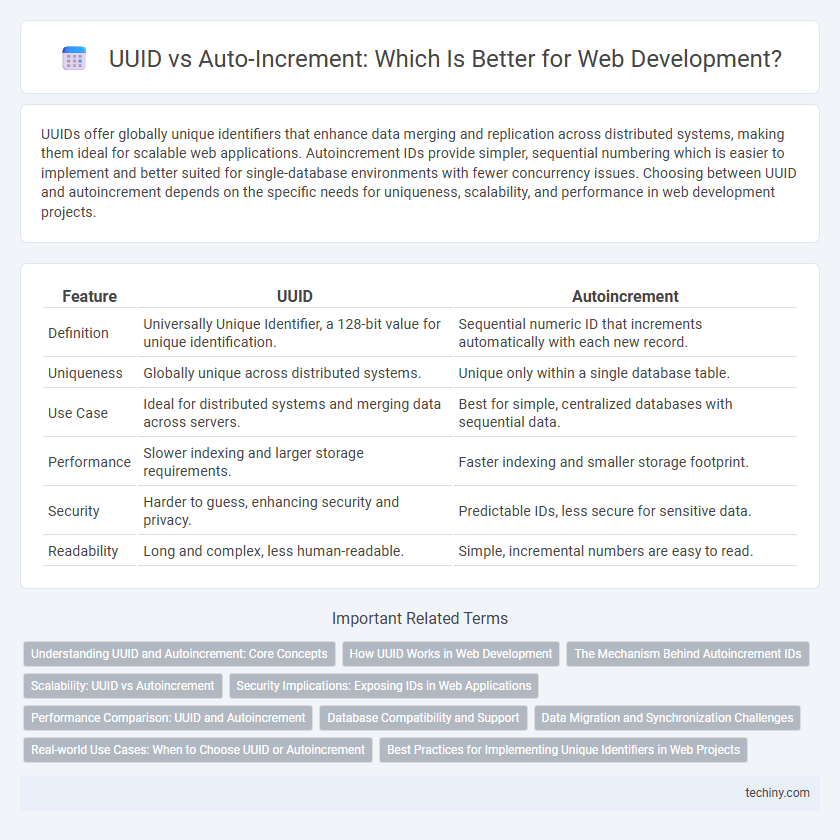UUIDs offer globally unique identifiers that enhance data merging and replication across distributed systems, making them ideal for scalable web applications. Autoincrement IDs provide simpler, sequential numbering which is easier to implement and better suited for single-database environments with fewer concurrency issues. Choosing between UUID and autoincrement depends on the specific needs for uniqueness, scalability, and performance in web development projects.
Table of Comparison
| Feature | UUID | Autoincrement |
|---|---|---|
| Definition | Universally Unique Identifier, a 128-bit value for unique identification. | Sequential numeric ID that increments automatically with each new record. |
| Uniqueness | Globally unique across distributed systems. | Unique only within a single database table. |
| Use Case | Ideal for distributed systems and merging data across servers. | Best for simple, centralized databases with sequential data. |
| Performance | Slower indexing and larger storage requirements. | Faster indexing and smaller storage footprint. |
| Security | Harder to guess, enhancing security and privacy. | Predictable IDs, less secure for sensitive data. |
| Readability | Long and complex, less human-readable. | Simple, incremental numbers are easy to read. |
Understanding UUID and Autoincrement: Core Concepts
UUID (Universally Unique Identifier) is a 128-bit value designed to provide unique identification across distributed systems without central coordination, ensuring high scalability and low collision risk. Autoincrement is a database-generated numeric sequence that assigns incremental values, primarily used for primary keys within a single database context, offering simplicity and natural ordering. Understanding these core concepts highlights UUID's advantage in distributed environments and Autoincrement's efficiency in centralized database operations.
How UUID Works in Web Development
UUID (Universally Unique Identifier) in web development generates a 128-bit value used to uniquely identify information without requiring a central authority, making it ideal for distributed systems. Each UUID combines timestamp, hardware, and random components to ensure near-zero collision probability, enabling secure and scalable database indexing. Web applications leveraging UUIDs benefit from decentralized ID generation, facilitating seamless data merging and synchronization across multiple servers and services.
The Mechanism Behind Autoincrement IDs
Autoincrement IDs generate unique keys by incrementing a numeric value sequentially within the database, ensuring each new record receives a distinct identifier. This mechanism relies on a counter stored in the database system, which updates automatically upon each insertion, minimizing the risk of key collision. Unlike UUIDs, autoincrement IDs provide faster index performance and simpler storage but are more vulnerable to exposure of insertion order.
Scalability: UUID vs Autoincrement
UUIDs provide superior scalability in distributed web development environments by enabling unique key generation across multiple servers without coordination, eliminating bottlenecks associated with centralized ID assignment. Autoincrement IDs rely on a single database node to generate sequential keys, which can lead to contention and scaling challenges as traffic grows. Using UUIDs enhances horizontal scaling and supports microservices architectures by allowing concurrent writes without risking primary key conflicts.
Security Implications: Exposing IDs in Web Applications
UUIDs enhance security in web applications by generating unique, random identifiers that are difficult to predict or guess, reducing the risk of enumeration attacks. In contrast, auto-increment IDs are sequential and easily exposed, allowing attackers to infer the number of records or access unauthorized data by incrementing the ID value. Implementing UUIDs prevents direct exposure of internal database schemas and strengthens overall access control mechanisms.
Performance Comparison: UUID and Autoincrement
UUIDs generate unique identifiers across distributed systems without coordination, but their larger size and random nature can lead to slower index performance and increased storage requirements compared to autoincrement integers. Autoincrement keys offer faster inserts and more efficient indexing due to sequential values, reducing page splits and improving cache locality in relational databases. Choosing between UUID and autoincrement impacts database performance, scalability, and replication strategies in web application development.
Database Compatibility and Support
UUIDs provide broad database compatibility as they are supported natively by most modern relational databases like PostgreSQL, MySQL, and SQL Server, enabling globally unique identifiers across distributed systems. Autoincrement fields offer straightforward support in databases such as MySQL and SQLite but can face limitations or require workarounds in distributed or multi-master environments due to their sequential nature. Choosing between UUID and Autoincrement depends on the specific database's native support and the need for uniqueness across multiple nodes or shards in a web development project.
Data Migration and Synchronization Challenges
UUIDs offer globally unique identifiers that simplify data merging across distributed systems, reducing conflicts during migration and synchronization. Autoincrement keys, while simpler for local databases, often cause ID collisions when consolidating data from multiple sources, necessitating complex remapping or conflict resolution strategies. Implementing UUIDs enhances seamless synchronization and scalability in web development data workflows.
Real-world Use Cases: When to Choose UUID or Autoincrement
UUIDs are ideal for distributed systems and applications requiring unique identifiers across multiple databases or servers, such as in microservices architectures or global e-commerce platforms. Autoincrement IDs perform best in single-database environments like traditional web applications or content management systems where sequential, easily indexed keys improve query performance. Choosing UUIDs enhances scalability and data merging flexibility, while autoincrement IDs optimize simplicity and storage efficiency for localized database operations.
Best Practices for Implementing Unique Identifiers in Web Projects
UUIDs provide globally unique identifiers that are ideal for distributed web applications, preventing collisions without coordination between databases. Autoincrement IDs, while simple and efficient for single-database environments, can expose sequential patterns and complicate data merging in distributed systems. Best practices recommend using UUIDs for scalability and security in modern web projects, reserving autoincrement IDs for straightforward, centralized databases where simplicity and performance are paramount.
UUID vs Autoincrement Infographic

 techiny.com
techiny.com